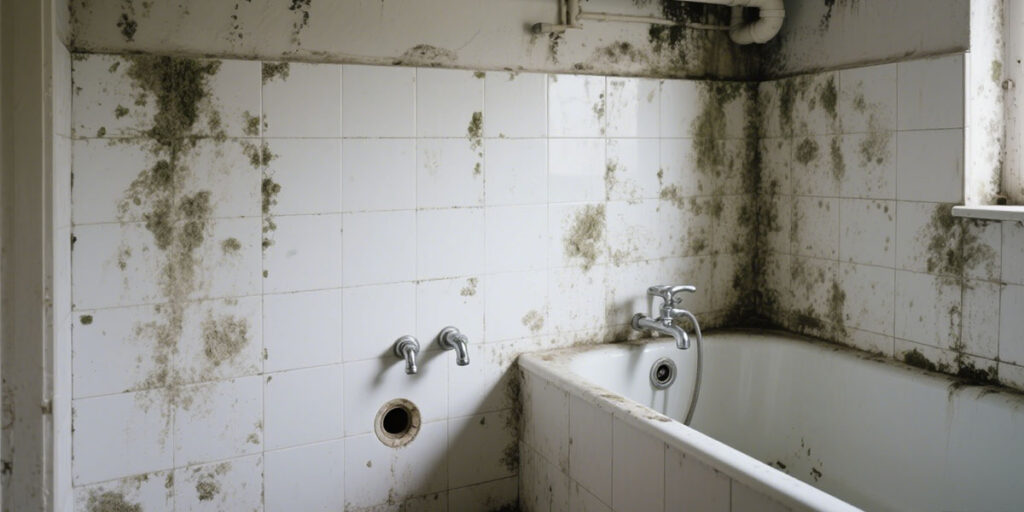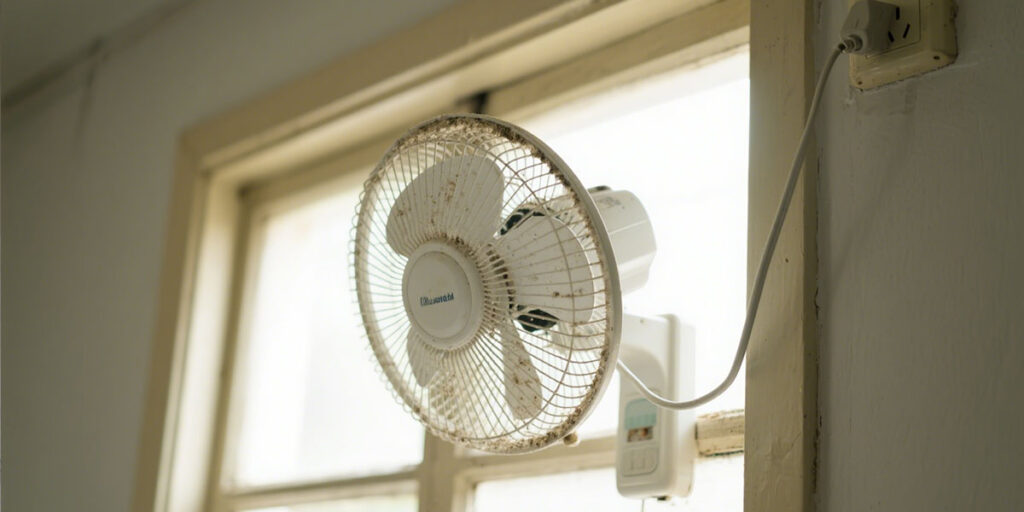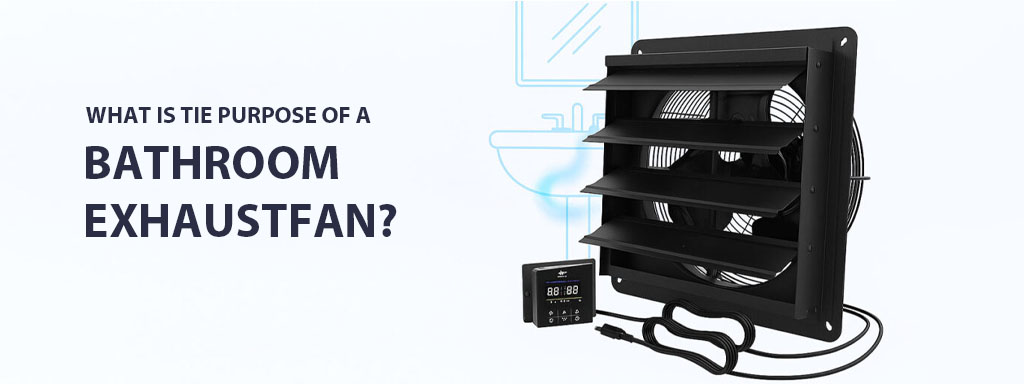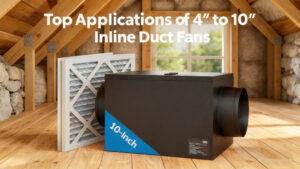Did you know that just one hot shower can release over a pint of water into the air? Without a way to vent that moisture, it clings to surfaces, fueling mold growth, peeling paint, warped wood, and even respiratory issues like allergies and coughing. That is where a bathroom exhaust fan becomes essential.
A bathroom exhaust fan quietly works behind the scenes, pulling humid air out and allowing fresh air to circulate. This not only protects your health but also preserves your walls, ceiling, and fixtures. In fact, U.S. building codes often require them, especially in bathrooms without operable windows. For large bathrooms, high-capacity models like a 576 CFM shutter fan can ventilate up to 1300 sq. ft. effectively. Let’s explore why this small fixture plays a massive role in home health and safety.
What a Bathroom Exhaust Fan Actually Does
A bathroom exhaust fan is a mechanical ventilation device that does more than just clear steam after a shower. Understanding how these devices work helps homeowners get the most out of them and protect their homes from moisture damage.
1) Pulls air out of the room
The main purpose of a bathroom exhaust fan is to remove excess moisture from the air. Bathrooms have high humidity during showers or baths, a perfect environment for mold growth and structural damage. When turned on, the fan creates negative pressure that draws warm, moist air up into the fan housing.
This mechanical action reduces humidity levels and prevents water vapor from accumulating on mirrors, walls, and other surfaces. For best results, the fan should run for at least 30 minutes after showering, as not running the fan long enough causes 90% of moisture damage problems.
2) Vents to the outside
Once the fan pulls in humid air, it must vent that air completely outside the home, not into attics, crawl spaces or wall cavities. The fan connected to ducting creates a pathway for moisture to exit the building envelope entirely. This proper venting is critical because when moist air is released into enclosed spaces like attics, it condenses on cooler surfaces and can cause severe damage.
Moisture in attics can rot framing, damage roof decking and create perfect conditions for mold growth. Plus modern homes are well insulated and nearly airtight so mechanical ventilation is not just helpful but necessary for good indoor air quality.
3) Supports whole house ventilation
Beyond moisture control, bathroom exhaust fans contribute to whole house ventilation systems. They remove odors and potentially harmful fumes from cleaning products. They also create air circulation throughout the home with replacement air flowing through doorways or windows.
In some advanced setups, bathroom fans can work with smart outlets with built-in air quality sensors that detect pollutants throughout the home, especially helpful in modern airtight homes. Proper bathroom ventilation also meets building code requirements with most fans rated in cubic feet per minute (CFM) to ensure adequate air changes per hour.
Problems That Happen Without Ventilation

Not ventilating your bathroom properly creates the perfect conditions for several serious problems that affect your home’s structure and your family’s health. Understanding these issues shows why bathroom exhaust fans are not optional fixtures but essential parts of a well maintained home.
1) Mold and mildew growth
Bathrooms without proper ventilation become mold and mildew breeding grounds. These fungi thrive in warm, humid environments so poorly ventilated bathrooms are particularly susceptible. Mold typically starts as dark spots on surfaces, while mildew appears as gray or white powdery patches. Beyond being ugly, these growths are a health risk especially for people with respiratory conditions or allergies.
Exposure can cause coughing, wheezing, nasal congestion and skin irritation. Long term exposure can worsen asthma or lead to more severe respiratory issues. Mold typically appears first on bathroom ceilings before spreading to walls, corners and hidden areas behind fixtures.
2) Peeling paint and warped wood
Too much moisture destroys bathroom surfaces and structures. Paint and wallpaper peel as humid air causes adhesion loss beneath the surface. As moisture penetrates deeper, wooden elements absorb water and warp, crack and rot. Throughout the bathroom, constant dampness can damage drywall, loosen tiles and compromise structural integrity.
In extreme cases moisture can get into wall cavities and affect framing and create expensive repair situations. Under these conditions wooden cabinets are particularly vulnerable as they expand during high humidity and contract as humidity drops and paint cracks and peels rapidly.
3) Lingering odors and poor air quality
Beyond visible damage, poor ventilation creates an unhealthy environment. Without proper airflow, bathrooms trap odors that linger long after the source is gone. Meanwhile, chemicals from cleaning products stay in the air and can cause headaches, fatigue and respiratory irritation.
This poor air quality extends beyond the bathroom as airborne contaminants and mold spores can spread throughout the home. And stuffiness when you enter the bathroom is the first sign of ventilation problems. Properly installed bathroom exhaust fans remove these contaminants and improve air quality and prevent moisture damage.
👉 Shop premium Bathroom Exhaust Fans to protect your space from moisture damage and odors.
Choosing the Right Fan for Your Bathroom
Choosing the right bathroom exhaust fan requires careful thought on several factors to get moisture removal right. First, understanding fan capacity will help you make an informed decision on which one is best for your space.
CFM ratings
CFM (cubic feet per minute) measures how much air a fan can move. For most bathrooms, the rule of thumb is to choose a fan with at least 1 CFM per square foot of floor space. For smaller bathrooms under 50 square feet, a 50 CFM fan is the minimum. As bathroom size increases, so should fan capacity:
- For bathrooms 46-75 square feet: 70-80 CFM fans
- For bathrooms 76-105 square feet: 110 CFM fans
- For bathrooms over 105 square feet: 150 CFM fans
For bathrooms with high ceilings or multiple fixtures, calculate CFM requirements by adding 50 CFM for each toilet, shower or bathtub, plus 100 CFM for jetted tubs.
When to choose a 576 CFM shutter exhaust fan
Larger spaces need more powerful ventilation solutions. The 576 CFM shutter exhaust fan is perfect for big bathrooms, especially those over 150 square feet or with multiple shower areas. These high-capacity fans have built-in thermostats that turn on automatically when temperatures reach preset levels, so ventilation only happens when needed.
This saves energy without sacrificing performance. For residential properties with master bathrooms, home theaters or recreation rooms over 100 square feet, check out shutter exhaust fans designed for larger spaces.
Why Size and placement matter
Beyond capacity, proper fan placement is crucial. Fans should be installed on firm wall surfaces at least 1.8 meters from the ground, with a minimum 5cm clearance from the ceiling. Also, duct size must match fan capacity—most 50 CFM fans work with 4-inch ducts, but higher CFM models require 5-inch or 6-inch ducts.
The distance between the fan and the exterior vent directly impacts its performance. Longer duct runs with multiple bends decrease efficiency and often require higher CFM ratings to compensate. So whenever choosing a bathroom exhaust fan, consider the physical space and installation requirements to get moisture control and ventilation right.
Installation and Long-Term Care Tips
Proper installation and regular maintenance will ensure your bathroom exhaust fan works for years to come. Understanding these practical tips will prevent costly repairs and maintain good indoor air quality.
How to install a bathroom vent correctly
When installing a bathroom exhaust fan, the best way is to vent it directly through the roof. First turn off the power at the circuit breaker before starting any electrical work. Start by finding the ideal position between ceiling joists then cut a hole sized accordingly for your fan unit. After that connect the fan housing to the ceiling joists using mounting brackets.
For ducting use insulated duct material to prevent condensation especially in colder climates. The duct should follow the most direct route possible with minimal bends. Each bend reduces airflow efficiency. Seal all duct connections with foil duct tape or mastic, not regular fabric duct tape which deteriorates over time.
Why venting to the attic is a bad idea
Many homeowners vent bathroom fans into attic spaces to avoid roof penetrations. But this practice is against building codes and creates serious problems. The International Residential Code states “air shall not be exhausted into an attic, soffit, ridge vent or crawl space”.
In those cases warm, moist air condenses in the cooler attic space and mold grows on the roof sheathing. Insulation becomes less effective, and structural components may rot and deteriorate over time. In some cases, this moisture damage can affect roof integrity and void warranties on roofing materials.
How often should to clean your fan
Clean your bathroom exhaust fan at least once a year to ensure optimal performance. First, turn off the power at the circuit breaker for safety. Then, remove the grille cover and wash it with mild detergent and water. Vacuum dust from the fan body using a brush attachment, then wipe components with a damp cloth and mild soap.
Never use harsh chemicals or solvents when cleaning and avoid getting water to electrical connections. For high capacity systems like 576 CFM shutter exhaust fans regular maintenance is more important as these powerful units collect more dust due to higher air volume.
Signs You Need to Replace Your Exhaust Fan

Even the best fans don’t last forever. Watch out for these warning signs:
- Loud or rattling noises
- Fan doesn’t start or runs weakly
- Lingering odors and foggy mirrors
- Water stains or mold growth
- Physical damage or rust
If your current model is not powerful or efficient, consider upgrading to a new one like the 576 CFM Shutter Exhaust Fan for better performance and air quality.
Conclusion
The purpose of a bathroom exhaust fan goes beyond eliminating odors. It’s an essential appliance that protects your bathroom from moisture damage, mold, poor air quality and long term structural wear. Whether you’re fitting a small guest bathroom or a large master suite, choosing the right exhaust fan is key to long term comfort and safety.
Are you looking for a high-efficiency upgrade like the 576 CFM Shutter Exhaust Fan or need help installing a Bathroom Vent? Aitecac has the products and resources you need to get started.Browse a full range of Bathroom Exhaust Fans and ventilate your home or building today!





